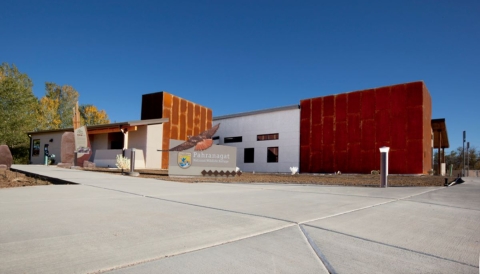Visit Us
National Wildlife Refuges offer us all a chance to unplug from the stresses of daily life and reconnect with our natural surroundings. Whether hiking, hunting, camping, or fishing, your visit will be enriched with beautiful landscapes and wildlife here at Pahranagat NWR. Best of all there is no cost to visit!
Location and Contact Information
About Us
A Managed Sanctuary...
The Pahranagat National Wildlife Refuge is managed as a sanctuary where present and future generations of people can discover a connection to the rhythms of life. In spring, indigo bush and beavertail cactus bloom at the edges of verdant meadows and wetlands, fed by brimming lakes. The vital spring-fed waters of this Mojave Desert oasis attract thousands of migratory birds each year. Pahranagat NWR’s seasonal marsh, wet meadows, and alkali flats provide high-quality resting and foraging habitat for wintering and migrating waterfowl, shorebirds, and other waterbirds along the Pacific Flyway. Riparian gallery forests of willow, cottonwood, and associated plant communities support a flourishing population of the endangered southwestern willow flycatcher, as well as a rich diversity of migratory and resident songbirds, colonial nesting species, and birds of prey. Coveys of Gambel’s quail emerge at dusk, along with abundant cottontails and jackrabbits, as nighthawks, coyotes, and owls begin to hunt. Each fall brings returning waterfowl and waterfowl hunters, while mountain lions follow mule deer down into the valley.
...with so much to explore!
Pahranagat NWR’s recreational opportunities will bring visitors into close proximity with wildlife. There have been 264 bird species recorded on the refuge, which is over half of all birds recorded in the state of Nevada! Visitors also have the opportunity to experience five different habitats all in one afternoon here at the Refuge. Click here to watch a film and learn more!
Tours
Ranger-Led Guided Hikes Schedule*
Check back for upcoming programs!
What We Do
The National Wildlife Refuge System is a series of lands and waters owned and managed by the U.S. Fish and Wildlife Service. Wildlife conservation is at the heart of the refuge system. It drives everything we do from establishing the purpose of a refuge, to the recreational activities offered there, to the resource management tools we use. Selecting the right tools helps us ensure the survival of local plants and animals and helps fulfill the purpose of the refuge.
Our Organization
The mission of the National Wildlife Refuge System is to administer a national network of lands and waters for the conservation, management and, where appropriate, restoration of the fish, wildlife, and plant resources as well as their habitats within the United States for the benefit of present and future generations of Americans.
Whether you want to further conservation, learn more about nature, or share your love of the outdoors, you’ve come to the right place. National Wildlife Refuges provide many opportunities for you to help your community by doing what you love. National Wildlife Refuges partner with local nonprofit organizations, volunteers, youth groups, landowners, neighbors, and residents of urban and coastal communities to make a lasting difference. Find out how you can help make American lands healthier and communities stronger while doing something personally satisfying.
Projects and Research
Refuges use a wide range of land management tools based on the best science available. Some refuges use prescribed fires to mimic natural fires that would have cleared old vegetation from the land helping native plants regenerate and local wildlife to thrive. Other refuges contain Wilderness areas where land is largely managed in a passive manner. The management tools used are aimed at ensuring a balanced conservation approach where both wildlife and people will benefit.


